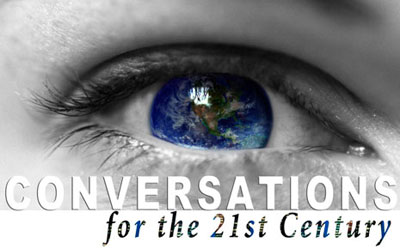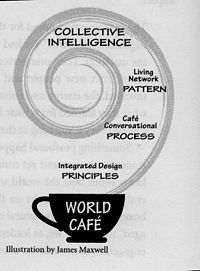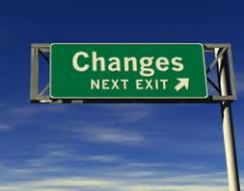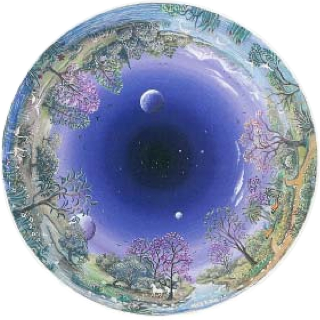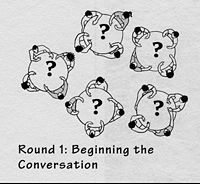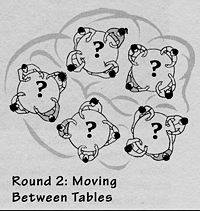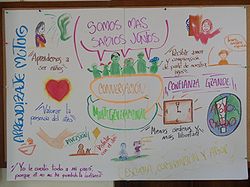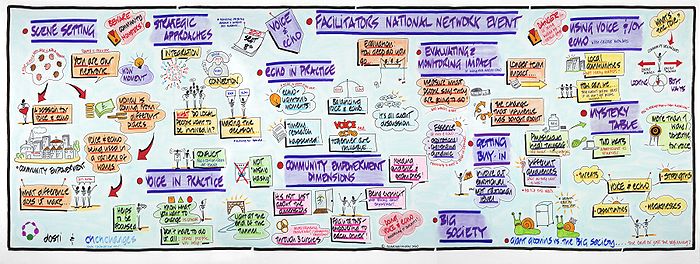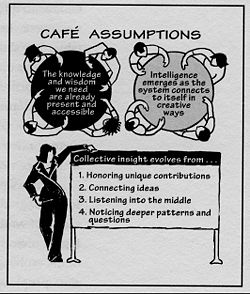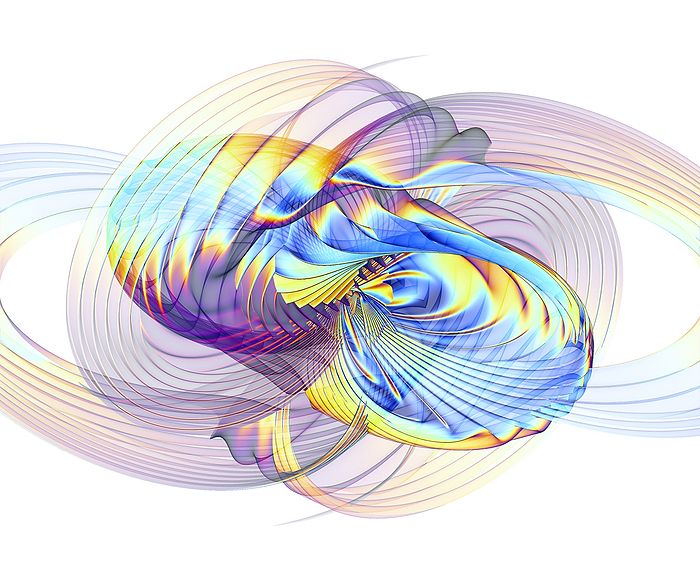The World Cafe: Shaping Futures Through Questions That Matter
Contents
- 1 What is the power of a good conversation
- 2 What is the World Café?
- 3 Overarching Principles and Perspectives of the World Café:
- 4 The Organization of The World Café:
- 4.1 1. Set the Context.
- 4.2 2. Create a Hospitable Space.
- 4.3 3. Explore Questions That Matter
- 4.4 4. Encourage Everyone’s Contribution
- 4.5 5. Cross Pollinate and Connect Diverse Perspectives
- 4.6 6. Listen Together for Patterns, Insights, and Deeper Questions
- 4.7 7. Harvest and Share Collective Discoveries
- 4.8 Roles
- 5 Intelligence
- 6 Resources Needed
- 7 Conclusions
- 8 Resources
What is the power of a good conversation
Why is it that some questions grab the attention and energy of a group, and others don’t seem to lead anywhere? How can we enhance our capacity to talk and think more deeply together about the critical issues facing our communities, our organizations, and our planet? How can we apply what we know about living systems to understanding how organizations and communities innovate? What sorts of underlying principles are at the heart of social systems and any complex system, and what does that tell us about the most effective way to create change within those systems? How can we access the mutual intelligence and wisdom we need to create innovative paths forward? These are some of the questions at the root of this facet of civic intelligence.
What is the World Café?
The World Café is essentially a conversational process, based on a set of integrated design principles, that reveal a deeper living network pattern, through which we coevolve our collective futures. (Holman, pg. 180) It is a human process methodology that first emerged in 1995 as a result of facilitation by Juanita Brown and David Isaacs at a series of conversations by Intellectual Capital Pioneers, an interdisciplinary group engaged in a level of deep inquiry into knowledge and leadership.
The World Café is an emergent process for thinking together focused on creating coherence without control. (Holman, pg. 188) It utilizes the natural processes of intimate conversation to create the conditions for the collective consciousness to emerge in a way that cannot be predicted. Through the integrated design principles, a sense of the dynamic qualities inherent in any group are made more visible and palpable, and this often leads to a surprising degree of group resonance and unity around the significant questions at hand.
This format for facilitating what is really important has been utilized by executive MBA programs, Hewlett-Packard, Mexico’s National Fund for Social Enterprise, and thousands of other people in widely diverse communities and organizations around the world. It can serve to jumpstart innovation and coherence within a community, and especially across diverse communities. This author believes, therefore that this process, and others like it, must form the heart of any movement to build a society that is more self aware, intelligent, and responsive to the changing demands of the 21st century.
Overarching Principles and Perspectives of the World Café:
There are many concepts at play in the theory and practice of the World Café:
Some of the principles at the heart of the origins of the World Café stem from the work of architect and philosopher Christopher Alexander, author of A Pattern Language (1977), Learn more. and a visionary across many fields. He applied an understanding of how large complex systems are made up of wholes, at every level of scale, up to and including cities and societies. The aspects of his work that contributed to the development of The World Café was the concept that change in complex systems comes from a large number of small adjustments, such as conversations that matter, as opposed to more “traditional” command and control methodologies for business, government, etc…
The World Café is also Open Source in nature, free for communities to use and cross pollinate new ideas into the ongoing exploration of how to catalyze human potential and create fundamental change in an organic and natural way. It has been combined with other large group processes like Open Space, Future Search, and others.
One of the key design principles to be outlined below is Back to the Roots, as many key elements of the theory, metaphor, and language come from the earth and the natural balance of chaos and order in ecosystems and any living system. Imagery such as 'seeding ideas,' 'gleaning insights,' and other natural metaphor can have a deep effect on the states of mind and energy of participants.
The process of Meta Cognition is integrated into the process as well, as participants are invited throughout the café to bring awareness not just on a given topic, but also on the way they speak about the issue. (Holman, pg. 190) This can lead to deeper appreciation of unexamined assumptions, about other people, or a situation, or the various contexts that shape perspective, the framing, if you will.
Another key principle that I’ve gleaned is the Great Good Place, as sociologist Ray Oldenburg named the importance of informal gathering places in the development of culture throughout history. According to Oldenburg, the third place is a locale that exists apart from the “womb” of family space and the “rat ace” of the modern world. (Brown, pg. 67) In his TED talk, Steven Johnson makes the connection between the flowering of the Renaissance and the presence of coffeehouses in England where people were engaged in generative discussions. [Watch his TED talk here.]
It is also clear that this methodology is designed on the assumption that everyone already has within him or her the wisdom and creativity to effectively address even their most difficult problems. (Holman, pg. 181) That assumption creates the opening, or the listening for participants to be empowered and step into their own leadership. This is crucial in allowing the Collective Intelligence to emerge, as we will explore later.
Systems Theory and the Components of Living Systems
In order to shed light on the design structure of the World Cafe, I will use this field of study to illustrate how this process can work:Living systems are composed of a number of different properties, in an inherently beautiful and graceful complexity that comes when the effects of chaos are observed… Michelle Holliday and many others have discussed the interwoven systems of nature, how there are similar patterns at vastly different scales, and then how a complex system like a human network, an industry, a festival, a weather system, all follow this underlying set of principles.
Briefly:
- There are Diverse Parts of whatever system we are looking at, at whatever scale we are choosing to look, and the more diverse these parts, the more resilient the system.
- There are Relationships, in a constantly changing web. The more Open and Free flowing these relationships are, the more creative, resilient, and adaptable the system will be.
- There is a whole, an Emergent level of living complexity that is more than the sum of it’s parts. The more Convergent the whole, the more coherent the form, that is still recognizable as a whole, even as the parts change, (the bodies’ individual cells die, animals in the forest die as part of the cycle) the more Resilient and Adaptable.
- There is the Self-Integrating property, or in other words, Self-Organization, that integrates the parts into the whole in a dynamic dance of constant rebirth and change.
Now let's explore the power of a conversation!
The Organization of The World Café:
This project has been based on an integrated design process, and has grown out of other large group processes that have been exploring ways to better harness human potential for many years.There are Seven Key Design Principles that make up the structure of the World Café in practice, and these elements are the foundation of what makes this model work.
1. Set the Context.
The context is similar to framing, in that it involves creating the “flexible boundaries in which the groups collaborative learning unfolds” (Brown, pg. 49). If there were three bowls on a table, nested together, the smallest one would represent the Content of the conversation, the middle bowl would represent the Process that was used to have the conversation, and the larger bowl represents the Context that contains it all. According to Brown, there are important aspects to building context, namely Purpose, Participants, and Parameters. Generally, the larger the gathering, the more extensive pre-planning and work must be put into these elements. “Why are we bringing these people together?” What are the underlying socio-economic, political, or personal issues within this group? Which brings us to the question of Who is coming, and who would it be good to have to build the diversity to allow a potent conversation? According to Brown, diversity of thought and experience is the most important requirement for accessing collective wisdom, and that makes this an opportunity to seek participants beyond the “usual suspects”. Finally, the Parameters includes determining how this format will be implemented, whether there will be any more traditional style meeting structures, and what sort of activities are used before and/or after the event to set the tone, and activate potential for carrying the insights and connections made out into the rest of the world.2. Create a Hospitable Space.
This refers to both the physical and the social (and to some people, energetic) environments. The process tends to support people buy creating psychological safety and openness, and lessen personality traits that can shut down conversation, like unchecked ego and attachments to one’s own point of view. As for the physical space, small tables are set up in a large room, with four chairs to each table. Tablecloths are laid down, usually big pieces of white paper. At the first World Café, when Jaunita and David brought tables indoors, it was a spontaneous response to the rain, and in a surge of playful creativity, they put down paper, and crayons and art supplies, and flowers in vases. The event was very successful and full of highly innovative, creative energy, and the small tables have become an integral part of the World Café. There are many ways to transform a space into someplace welcoming and relaxing, from large boardroom, to a community art studio. Part of creating a welcoming space also comes through a shared understanding of how participants are encouraged to treat each other through the course of dialog.
Some basic Café Etiquette pointers often mentioned:- FOCUS on what matters.
- CONTRIBUTE your thinking and experience.
- LISTEN to understand.
- CONNECT ideas.
- LISTEN TOGETHER for patterns, insights, and deeper questions.
- PLAY, DOODLE, DRAW!
“Hospitality, is the act of affirming gifts in others. It is entertaining ideas that enable us to see life in a new way. When we offer hospitality to the stranger or guest, we welcome something new, unfamiliar, or unknown into our lives that has the potential to expand our world.” ~Herbert Anderson (Brown, pg. 67)
3. Explore Questions That Matter
There is an art to finding the right questions to ask a group, questions that may lead to the kind of inspiring and innovative conversations that we are talking about.
“Genuine questions – ones for which we don’t already have answers – are open invitations to innovation.” ~(Brown, pg. 90)
Some guidelines for what make a good question comes form the Art of Hosting: A powerful question is one that…
- Is simple and clear
- Is thought provoking
- Generates energy
- Focuses inquiry
- Challenges assumptions
- Opens new possibilities
- Evokes more questions
The process of finding the questions that will be discussed is also a dance, between the facilitator and the group. Certain questions are more powerful than others for eliciting inspired dialog. The sentence construction and scope of the question can have a big impact. This is where the magic starts to happen. Participants are given the first question for the first round, or perhaps the group is polled to get a sense of what is present, and then people sit down at a table with three other people, and discuss, share, listen, doodle, and draw for 20 minutes, at which time one of the people at each table are invited to stay there and anchor that table, and the other three people go find three other tables with totally different groups, for round two. Over the course of 2-4 rounds of conversation, there comes a building sense of group coherency, as participants are aware that while they are part of a small group conversation, they are part of a much bigger whole, and as key themes and ideas come up in different places, in different flavors often the energy in the room can feel electrified.
4. Encourage Everyone’s Contribution
By inviting all participants to contribute, there is a slightly different meaning than change methodologies that focus on individuals’ participation, or empowerment. Those can sometimes lead to an emphasis on the individual; I’m voicing my opinions, I’m speaking up, etc… There is a subtle difference with contribution, there is more relationality there, between the I and the We. Everything we have talked about so far in terms of the structure combines and enhances a sense of radical self empowerment and self expression, but from a whole systems perspective. Because I am able to deeply listen to people who are very different than me, and we have created a basis of trust and openness of ideas. The facets of Café etiquette mentioned earlier work toward this.
“If you go to someone’s home and they offer you their food, they’re giving something of themselves. Once people give, then their heart is involved. Giving – making your contribution – is what brings community alive.” ~Cesar Chavez
5. Cross Pollinate and Connect Diverse Perspectives
As the rounds of conversations go on, hosts and participants will often marvel at the type and feel of energy that is created, as the energy in the room rises. As people move from table to table and from conversation to conversation, attachments to rigid beliefs are encouraged to fall away, perhaps because everyone takes responsibility for carrying the key insights from their previous conversations forward, and finding the similarities and differences in a spirit of openness and curiosity rather than debate.
In the book The Embodied Mind several cognitive scientists look at the fascinating subject of human learning, and how brain development mirrors the fundamental nature of living systems. They found certain self-organizing and emergent properties, and explored how language and learning in the brain are linked to the “social coupling through language in the network of conversations” (Brown, pg. 113) This led to the theory of a potent question as an attractor that can catalyze this process. In this way, a good question seems to activate the conversational network’s self-organizing nature, an experience some people have described as Flow…
Here we see the essence of the Relationships between the diverse parts contributing to something greater than the sum of its parts, as we saw with the 4 characteristics of living systems.
6. Listen Together for Patterns, Insights, and Deeper Questions
At this part of the structure of the Café people tend to tune in to the themes and insights that are popping up everywhere, as well as listening for deeper assumptions and patterns of meaning. In what is really an exercise in Meta-Cognition, the group is encouraged, through the questions in the later rounds of discussion, to practice the kind of reflection and self awareness that can lead to new connections and discoveries. This author associates this element of the process to the third part of a dynamic living system, that of a cohesive whole, held together by the web of interactions and the network of generative conversation.
Tom Atlee calls the type of Collective Intelligence that emerges within this type of situation Co-Intelligence, to describe that sense of individual and group coherence, often described by participants and hosts as ‘magic’.
Participants are also encouraged to use provided paper and art supplies to translate these discoveries into visual language, with pictures, diagrams, etc…
This is the last section of the World Café process, where the group gathers together as one large group again, in multiple concentric circles if necessary for larger groups, and a graphic recorder or several will draw on large paper the results as people share their experiences. This can be one of the more challenging aspects of the process, to allow for the flow to continue in a similar fashion when in such a large group. This element has the capability to translate the transformation experienced in the Café session out into the rest of the world, and also has a variety of options as to how it can be guided, depending on the group.
Roles
There are a variety of main roles involved in holding this type of event for a group or a community.
- The Café Sponsor or Convenor, this person or group commits to support the gathering and is usually invested in assisting the group reach its highest collective intelligence.
- The Design Team clarifies the purpose, and works in sync to ensure that the project unfolds in an emergent way, listening to the needs and feelings of the community to craft questions, invite participants, and coordinate logistics.
- The Café Host(s) work with the design team, and then Host the Café, and then follow up after with debriefing with the Design Team and the Sponsor.
- Graphics Professional is sometimes able to contribute their skills very effectively in the recording and gleaning of insights, and if present would be an integral member of the design team.
- Participants are responsible for talking about what really matters to them, with radical authenticity and speaking what is really true for them, keeping in mind the keys to Café etiquette. Participants also have the opportunity to make action commitments and carry the energy of the Café into the rest of their lives and communities.
Intelligence
In this study, we have explored a model that uses a complex and nuanced understanding of modern science, psychology, philosophy, and organizational theory be used to activate the mutual intelligence of large groups of people in ways that are only now beginning to be understood.
Resources Needed
How are the insights brought out during a World Café carried out beyond the Café?
The experience of the founders has shown that there are 3 important aspects that contribute to participants turning discoveries into Embodied Knowledge:
- A hospitable space for exploring their dimensions,
- A set of practices to ground them in their daily lives,
- A supportive community of explorers interested and passionate about continuing to ask questions that matter.
Any change initiative requires an ongoing commitment, and this one is no different, however, the potential exists for a community to experience a radical shift in awareness, perspective, and understanding around the issues that are the most present for them.
Conclusions
We have seen that the main way this group process does this is by harnessing the energy between individuals, rather than the focus on the individual that is so prevalent in our culture.
As Meg Wheatley suggests, as quoted in the Change Handbook “intelligence emerges as the system connects to itself in diverse and creative ways.” (Holman, pg. 190)
With some of the findings of modern neuroscience, we are seeing an evolving understanding, not only of what intelligence is, but of the powers of the mind, and the effect of very simple practices that can have vast effects on the collective consciousness of groups and communities.
It is the opinion of this author that it is crucial that we explore these areas further and develop more research in these fields, and to adjust the traditional ways of going about our lives in the process. The medium of collective intelligence is also the message, and with dedication and passion, we can shape our common future by learning how to navigate change with innovation and creativity.
Resources
Brown, Juanita, with Isaacs, David, The World Café: Shaping Our Futures Through Conversations That Matter, Berrett-Koehler Publishers, Inc. San Francisco, 2005
Holman, Devane, and Cady, The Change Handbook, Berrett-Koehler Publishers, Inc. San Francisco, 2007

